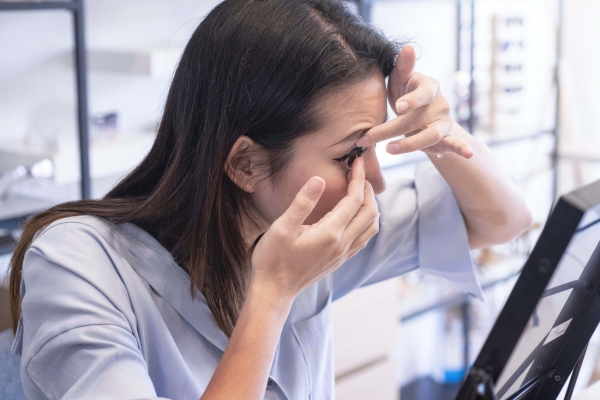
Contact lenses have been growing in popularity over the years as an alternative to glasses. They can give you a more natural look and many people opt for them over glasses for playing sports and attending events where glasses may otherwise be less convenient.
Read on to learn more about how to get contact lenses from your optician and online.
Do you need a contact lens prescription?
You will need to get a new prescription for contact lenses and the prescription you get for contacts will be different to your usual glasses prescription. It’s important that you go to your local Leightons branch for a contact lens assessment.
What happens in a contact lens assessment?
Contact lenses not only give freedom from spectacles, they can be more convenient and practical for sports and activities. A contact lens assessment is an appointment we offer specifically to help understand your prescription, how your contacts will fit, and also answer any questions you may have about contact lenses.
- Eye test – You’ll need to have had an eye test within the last couple of years. If you’ve not had an eye test in the last 2 years, make sure you have one done before your contact lens assessment.
- Understanding lenses – Our expert opticians will talk you through the types of contact lenses available and how they would suit your lifestyle and needs.
- Eye check – You will also receive an eye check of the front surface of your eyes to make sure there’s no medical reason that may stop you from wearing contact lenses.
- Fit, vision, and comfort check – Your optician will carry out a fit check of your chosen lenses to fit properly and that your vision is clear. They’ll also make sure you’re comfortable wearing the lenses and you’re confident in putting them in and removing them.
- Answering questions – if you have any questions or concerns about your lenses, your optician will be able to help.
Getting contact lenses in store
Whether you’re new to lenses or a frequent wearer, making a visit to your local Leightons branch is the best way to buy your contact lenses. You can easily renew your prescription, order more lenses, and update your subscription if you have one.

The process of getting contact lenses in store:
- Eye test – Make sure you have had an eye test within the last 2 years before being assessed for contacts. If you got it done at another optician, just bring your contact lens prescription slip with you.
- Contact lens assessment – Your optician will perform a contact lens assessment. They will discuss your lifestyle and eye health history, and inspect your eyes. They'll also assess your tear film to check if your eyes produce enough moisture for contact lenses.
- Fitting – Your optician will also perform a contact lens fitting check to ensure the lenses fit well, your vision is clear, and they're comfortable. They'll also teach you how to apply and remove your lenses.
- Trial lenses– If you’re new to contact lenses, or if you’re trying a new type of lenses, you'll be given trial lenses to wear for a few days.
- Follow-up appointment – You’ll be scheduled in for a follow-up appointment after your trial for a final test to check your eye health and vision. Once complete, you can purchase your contact lenses.
Can I just walk in and buy contact lenses?
Once you have an up-to-date contact lens prescription, you can walk into any Leightons branch to buy your contact lenses directly from us. Just bring us your contact lens prescription and we can order them for you to be delivered. Alternatively, sign up for our Lens Ordering Hub and order online whenever you need fresh lenses.
Buying contact lenses online
A convenient way to get contact lenses is online. Getting your contact lenses online allows you to refill your prescription whenever you need as well as sign up for and easily manage subscriptions. It’s important to get your prescription contact lenses online through reputable sources such as opticians, specialised online retailers, or pharmacies to ensure you’re getting safe, sterile, and genuine products.
We recommend signing up for the Leightons Lens Ordering Hub – simply enter your prescription details and you can order lenses whenever you need.
Tips on buying contact lenses online:
- Check your prescription – Make sure you have entered your contact lens prescription correctly into the correct fields.
- Check the base curve and diameter – The base curve and diameter of your lenses determine how well they fit your eyes so it’s really important that you get these measurements correct. If they're wrong, your lenses may move around, sit too tightly, or fall out.
- Stick to the same brand – Stick to the same brand of lenses that appears on your prescription to avoid any differences or discrepancies between brands.
- Order early – Make sure you place your order before you run out of contacts so you’re not left without while you wait for your new order to arrive. Leightons can create your personalised contact lens plan with our Lens Ordering Hub so your lenses will arrive at the same time every month to avoid running out.
What kind of contact lenses can I get?
There are many different types of contact lenses. All with their own advantages and drawbacks.
Daily disposables
Daily disposable lenses are designed to be worn once and thrown away. They are made of soft, comfortable materials and are ideal to be worn daily or on special occasions when glasses are the less convenient option.
Monthly and bi-weekly lenses
These are reusable lenses that can be worn repeatedly. You put them in in the morning and remove them before you go to bed, cleaning and storing them ready to use the next day. They’re great for people who enjoy a routine and are happy with daily maintenance.
Toric lenses
Special contact lenses designed to help with astigmatism. They are shaped to maintain a specific orientation on the eye, ensuring consistent vision correction and can be either daily or monthly lenses depending on your needs.
Multifocal lenses
Designed for those with presbyopia. These contact lenses combine prescriptions within a single lens for near, intermediate, and distance vision.
Rigid Gas Permeable (RGP) lenses
RGP lenses are durable contact lenses which offer exceptionally clear, crisp vision and are particularly beneficial for complex prescriptions or irregular corneas.

If you want to learn more about how to choose the right contact lenses that fit your lifestyle, check out our informational guide.
Follow-up and regular eye check-ups
Just like glasses, getting contact lenses isn’t a one-time event. Your eyes are continuously changing, so you’ll need to make sure you’re booking regular check-ups to ensure the lenses you have are still a good fit and that your vision hasn’t changed. Your optometrist will also check your eye health as well as discuss continued safe lens wearing with you. Any discomfort, redness, or vision changes need to be addressed immediately by your optometrist.
Ready to begin your contact lens journey?








